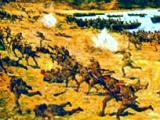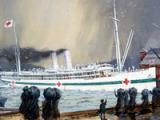The foundation was established in Australia by the Kiwi-born ophthalmologist (eye doctor) to treat eye problems in poorer countries. Within six years, 200,000 people had their sight restored through cataract surgery.
Health
Events In History
The report was triggered by the publication in Metro magazine of ‘An Unfortunate Experiment’, an article by Sandra Coney and Phillida Bunkle which alleged that cervical cancer patients at Auckland’s National Women’s Hospital were receiving inadequate treatment.
New Zealand schoolchildren received free milk between 1937 and 1967. The first Labour government introduced the scheme – a world first – to improve the health of young New Zealanders (and make use of surplus milk).
Pioneering heart surgeon Brian Barratt-Boyes performed the surgery using a heart-lung bypass machine. The procedure, at Green Lane Hospital in Auckland, was carried out on an 11-year-old girl with a hole in her heart.
In a world first, 30 women began training as dental nurses for the state-funded School Dental Service.
By the end of the year the epidemic, which was intoduced by a Mormon missionary, had killed 55 New Zealanders, all of them Māori.
As well as providing care for expectant mothers, the new St Helens hospital in Wellington trained midwifery students.
Elizabeth Robinson of Christchurch was the first woman to register as a pharmacist under a registration system established by the Pharmacy Act 1880.
Articles
Assisted immigration, 1947-75

New Zealand is a country of immigrants. Wave after wave of peoples have settled here: Polynesian, British, European, Asian. Read the full article
Page 2 - Peopling New Zealand
The Labour Department was responsible for setting up and administering the assisted immigration
The 1918 influenza pandemic

The lethal influenza pandemic that struck New Zealand between October and December 1918 killed about 9000 people in two months. No other event has claimed so many New Zealand lives in such a short time. Read the full article
Page 1 - The 1918 flu pandemic
The lethal influenza pandemic that struck New Zealand between October and December 1918 killed about 9000 people in two months. No other event has claimed so many New Zealand
Page 2 - The pandemic begins abroad
The 1918 influenza pandemic was commonly referred to as ‘the Spanish flu’, but it did not originate in
Page 3 - The pandemic hits New Zealand
Many people believed that the second wave of the 1918 influenza pandemic arrived in New Zealand as ‘a deadly new virus’ on board the RMS
Page 4 - Uneven rates of death
No other event has killed so many New Zealanders in so short a space of time. While the First World War claimed the lives of more than 18,000 New Zealand soldiers over four years,
Page 5 - Response to the influenza pandemic
There was a degree of consistency in New Zealand's response to the influenza pandemic, thanks to a telegram the Health Minister, George Russell, issued to all borough councils and
Page 9 - South Island influenza death rates
Death rates in South Island towns and counties from the influenza
The Gallipoli campaign

Each year on Anzac Day, New Zealanders (and Australians) mark the anniversary of the Gallipoli landings of 25 April 1915. On that day, thousands of young men, far from their homes, stormed the beaches on the Gallipoli Peninsula in what is now Türkiye. Read the full article
Page 7 - Soldiers' experience
Life for the New Zealand soldier on Gallipoli was tough. They struggled with the harsh environment, living and fighting amongst the deep ravines and high cliffs that towered above
School of Radiant Living

The School of Radiant Living was a movement active in New Zealand from the late 1930s until the late 1980s. Founder Dr Herbert Sutcliffe taught a holistic philosophy of physical, psychological and spiritual health. Read the full article
Page 1 - School of Radiant Living
The School of Radiant Living was a movement active in New Zealand from the late 1930s until the late 1980s. Founder Dr Herbert Sutcliffe taught a holistic philosophy of physical,
Page 2 - Herbert Sutcliffe
Biography of the founder of the School of Radiant Living in New
Page 3 - Teachings
The teachings of Radiant Living were complex and involved holistic psychological, physical and spiritual
Page 4 - Peloha
'On yonder hill you will pitch your tent' prophesied the daughter of Golden Dawn founder Robert Felkin to Herbert Sutcliffe, as she pointed towards Te Mata
Page 5 - The Havelock work
Havelock North has long been a centre of 'alternative thought' or liberal theology in New
Page 6 - Origins of Radiant Living
Radiant Living emerged from the American-based philosophical movement New Thought, which gained popularity in the late 19th
Page 7 - Edmund Hillary
One of the first New Zealand schools of Radiant Living was established in Auckland. Its secretary was Gertrude Hillary who reported progress early in 1939. Her son, Edmund, was an
Page 8 - The eliminating diet
To obtain physical fitness, it is of vital importance that the right mental attitude should accompany the food diet to enable the emotions, nerves and glands to co-operate with
Page 9 - Salad recipes
Colour, beauty, exquisite artistry find joyous expression in the Art of Salad Making. The homemaker who serves salads so deliciously and artistically tempting that the family
Children and adolescents, 1930-1960
The need for the New Zealand government to promote national interests during the Depression and the Second World War created a renewed appreciation of the role of the family within society. Read the full article
Page 2 - Children's health
By the late 1940s all New Zealand children had a medical examination on entering school, and were seen by a nurse at standards two and six. These examinations helped identify
Homosexual law reform

The homosexual law reform campaign moved beyond the gay community to wider issues of human rights and discrimination. Extreme viewpoints ensured a lengthy and passionate debate before the Homosexual Law Reform Act was passed in July 1986. Read the full article
Page 4 - Reforming the law
To bring about change in the law, the gay movement needed a parliamentary champion. It found one in Labour MP Fran
Passchendaele: fighting for Belgium
Ever since 1917 Passchendaele has been a byword for the horror of the First World War. The assault on this tiny Belgian village cost the lives of thousands of New Zealand soldiers. But its impact reached far beyond the battlefield, leaving deep scars on many New Zealand communities and families. Read the full article
Page 6 - Helping the wounded
More than 14,000 New Zealanders were wounded between June and December 1917 in Belgium, and medical staff, orderlies, chaplains and stretcher-bearers worked round the clock to
Pacific Islanders in the NZEF

Cook Islanders, Niueans, Fijians and Gilbert Islanders all took their place in the ranks of the New Zealand Expeditionary Force during the First World War. As well as the dangers of war, Pacific soldiers faced language difficulties, an unfamiliar army diet and European diseases. Read the full article
Page 2 - Niueans and Cook Islanders
Information about Niuean and Cook Island soldiers who were part of the 3rd Maori Contingent in
Merchant marine
On 3 September New Zealand honours Merchant Navy Day. Here we explore the little-known but vital role played by the merchant marine during the First World War, when these civilian seafarers often found themselves in the front line of the war at sea. Read the full article
Page 4 - Hospital ships
In May 1915, as casualties mounted at Gallipoli, the government chartered a hospital ship, the Union Company's 5282-ton trans-Tasman liner
Pacific aftermath
Participation in the First World War changed Pacific Islanders' lives. Returning servicemen had seen the world. Read the full article
Page 5 - Economic, social and political impact
The First World War opened the Pacific Islands to the world more than they ever had been
Schools and the First World War
Schools and children were quickly called into action at the outset of the First World War in 1914. Developing patriotic, fit and healthy citizens was seen as important to the survival of the country and the Empire. Hundreds of teachers joined the NZEF, including many from sole-teacher schools. Almost 200 never returned. Read the full article
Page 2 - Schools in 1914
The head of the Department of Education believed that ‘moral purpose should dominate the spirit of the whole school life.’ Schools and teachers were to shape children into
Hospital ships

The Maheno and Marama were the poster ships of New Zealand's First World War effort. Until 1915 these steamers had carried passengers on the Tasman route. But as casualties mounted at Gallipoli, the government - helped by a massive public fundraising campaign - converted them into state-of-the-art floating hospitals. Read the full article
Page 5 - Life on board
What was life like aboard a hospital ship? That largely depended on your job, your rank and your
Page 6 - Later service and legacies
The Marama missed Gallipoli, reaching the Mediterranean a few weeks after the Allies abandoned the peninsula. The ships’ service pattern would now be dominated by long voyages






























































